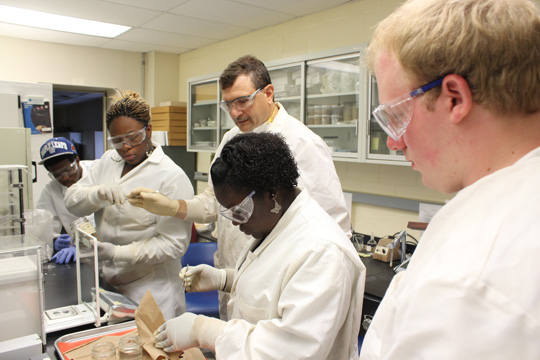|
home > 2012 feature stories
U.S. Department of Defense organizations launch inaugural Joint Science and Technology Institute
 |
Photo: Jennifer Carroll, U.S. Army Edgewood Chemical Biological Center
The U.S. Army Edgewood Chemical Biological Center (ECBC) hosts a tour of its state-of-the-art facilities for students and teachers participating in the inaugural Joint Science and Technology Institute (JSTI). |

|
Photo: Jennifer Carroll, U.S. Army Edgewood Chemical Biological Center
ECBC Environmental Toxicologist Michael Simini, Ph.D. helps four JSTI students explore the characterization of different soils using earthworms. |

|
Photo: Jennifer Carroll, U.S. Army Edgewood Chemical Biological Center
ECBC’s Packaging and Environmental Testing Team train JSTI students and Cecil County Public Schools teacher Nicole Sudler in designing, building and testing military packaging solutions. |

|
Photo: Graham Snodgrass, U.S. Army Public Health Command
Kerry Anne Kedzierski, a physics and STEM teacher from North East High School, observes as Michelle Mosso, a physical science technician at the USAPHC, conducts scientific techniques in one of the Command's research laboratories. |
ABERDEEN PROVING GROUND, Md. — The Defense Threat Reduction Agency’s Joint Science and Technology Office (DTRA-JSTO) partnered with the U.S. Army Edgewood Chemical Biological Center (ECBC), the U.S. Army Public Health Command (USAPHC), the U.S. Naval Research Laboratory (NRL) and the U.S. Army Criminal Investigation Laboratory (USACIL) to launch its inaugural Joint Science and Technology Institute (JSTI) from July 28 to Aug. 10.
The two-week residential program, administered by Oak Ridge Associated Universities (ORAU), afforded 23 high school students from Maryland and Virginia and six high school teachers from Cecil and Harford County Public Schools in Maryland the opportunity to work on leading-edge science, technology, engineering and math (STEM) projects with Department of Defense (DoD) scientists and engineers. In addition, students and teachers participated in extracurricular activities and toured sites, such as the Maryland Science Center, Fort McHenry and the National Aquarium in Baltimore.
“As leaders within the chemical and biological defense enterprise, we have a responsibility to attract and sustain a highly-skilled technical workforce that is prepared to protect our nation against current and future threats,” said Alan Rudolph, PhD, the director of the Chemical and Biological Technologies Department, DTRA. “With the establishment of the JSTI, DTRA’s goal was to demonstrate its commitment to DoD’s strategic STEM objectives. Therefore, we asked other DoD organizations to join us in this collaborative STEM effort and to help us provide participating students and teachers an innovative, hands-on STEM experience.”
After the two-week JSTI kicked off with a tour of ECBC’s state-of-the art facilities, students and teachers were divided into research groups led by mentors from each participating organization. Students conducted their science and engineering projects at ECBC’s and Harford Community College’s research laboratories.
“The chemical and biological defense community has been dedicated to offering students and teachers relevant hands-on STEM experiences,” said ECBC Technical Director Joseph D. Wienand. “I am very proud and honored that ECBC was part of this first-of-its-kind DoD STEM initiative and, that we were able to collectively make a significant impact in the lives of participating students and teachers.”
Students were divided into six groups with research topics ranging from water quality monitoring to the design and testing of military packaging solutions, soil toxicology, forensic science, testing of bacteria resistant surfaces, and operational research focused on Wounded Warriors.
“The opportunity to work in a biology lab with an environmental toxicologist has expanded my understanding and appreciation for this STEM field,” said 11th-grade student Daezha Logan from Galileo Magnet High School in Danville, Va.
Cody Short, 12th-grade student at Buckingham County High School, Va., was assigned to the same research group and added, “This experience has increased my interest in biology, because I’ve learned something new in everything we’ve done so far.”
Teachers’ research areas included the design and testing of military packaging solutions, air monitoring, disease surveillance, toxicology screening, tactical biological detection, as well as environmental chemical analysis.
The JSTI concluded with a closing ceremony Aug. 10 at the Clarion Hotel in Aberdeen, Md. with welcoming remarks from Wienand and a keynote speech from Maj. Gen. Jimmie O. Keenan, commander of the USAPHC. Students and teachers then presented their research results to family members and senior leaders of participating organizations.
Keenan, a nurse by profession, reminded students during her keynote address that they should consider a career in healthcare taking care of America's Sons and Daughters.
"The medical community needs individuals with the schooling and smarts to be doctors, nurses, behavioral health professionals, epidemiologists, engineers, and other scientific and technical disciplines that are STEM related."
For additional information on the Joint Science and Technology Institute, please visit: https.bit.ly/R6Wmk6.
STEM Outreach Stories: 2012
All feature stories: 2011 | 2010 | 2009 | 2008 | 2007 | 2006
 Print this page Print this page
|

